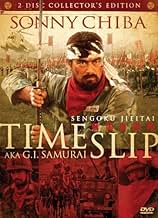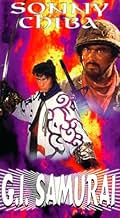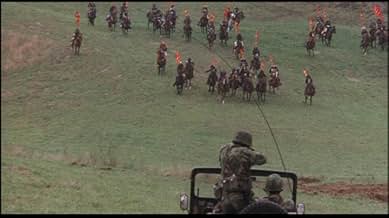ÉVALUATION IMDb
6,4/10
1,2 k
MA NOTE
Ajouter une intrigue dans votre langueJapanese soldiers time travel to feudal era. Their lieutenant allies with samurai lord to become Shogun. Both seek power through different eras' warfare.Japanese soldiers time travel to feudal era. Their lieutenant allies with samurai lord to become Shogun. Both seek power through different eras' warfare.Japanese soldiers time travel to feudal era. Their lieutenant allies with samurai lord to become Shogun. Both seek power through different eras' warfare.
- Prix
- 3 nominations au total
Shin'ichi Chiba
- Lt. Yoshiaki Iba
- (as Sonny Chiba)
Histoire
Le saviez-vous
- AnecdotesInitially the producers approached the Japan Ground Self-Defense Force (JGSDF) for props and vehicles, but the army withdrew its support after reading that soldiers go AWOL in the script. For that reason, old and sometimes outdated equipment (like M3 sub-machine guns) had to be used. The tank featured in the movie was even built entirely from scratch.
- GaffesNone of the vehicles run out of fuel despite being stranded 400 years before the creation of fossil fuels for weeks.
- Autres versionsInternational English language version has rock ballads replacing original haunting soundtrack.
- ConnexionsReferenced in Les Frénétiques (1982)
Commentaire en vedette
What if a platoon of G.I.'s from the Japanese army were to be send back in time 400 years right in the middle of the feudal wars that led to the formation of the Tokugawa Shogunate? Great pitch right? The movie does exactly what it says on the tin.
Thankfully the writers didn't bother to explain the, usually ridiculous in sci-fi movies, scientific mumbo jumbo of time transport. No how's or why's. They just did. However the time transport sequence itself is trippy as hell and quite beautiful, if not a bit dated. Not as silly as one would imagine.
The rest of the movie follows the premise to a T. But while it loses a bit of steam with the various subplots that follow the G.I.s arrival to medieval Japan, it picks up with a devastating battle sequence. Undoubtedly it's the main order of the day. The whole concept and by extension the movie itself, was probably originated from this simple pitch: what if G.I.'s equipped with the latest in modern warfare were to fight samurais? And boy does it deliver.
The main battle sequence that spans more than half an hour is probably one of THE best of its kind in 70's action/war movies. Not only is it relentless and exhausting in pace and length, it's also a terrific mish-mash of styles and techniques that only unique premises like G.I. Samurai can deliver. I mean, where else would you get the chance to feature tanks, ninjas complete with shuriikens, a helicopter and samurais in the same shot? The G.I. platoon led by lieutenant Iba tears literally through hundreds of extras, gunning them down with machine guns, mortars, grenades and tanks.
This mish-mash of styles is with one foot firmly rooted in the sprawling jidai-geki epic of Kurosawa's Kagemusha or Hiroshi Inagaki's Samurai Banners, while the other is in western action and war movies. There are stylistic touches (like the wonderful slow-motion shots and bloody violence) that bring Sam Peckinpah or Enzo G. Castellari circa Keoma to mind. Japanese cinema has always been influenced by westerns and other Hollywood works and vice versa, and G.I. Samurai effortlessly turns this east-meets-west melting pot into an exciting film.
The film-makers thankfully take the whole thing seriously and the movie benefits immensely from it. Not that tongue-in-cheek mentality is completely absent, it's just that it doesn't try to pander to so-bad-it's-good audiences that enjoy laughing at their movies. The budget was probably hefty, as it is evident in the hundreds of extras, elaborate costumes (very decent for a production that is not a traditional jidai-geki) and special effects. The camera-work and editing are all top notch, almost better than a movie with no higher artistic ambitions deserves.
It's not withouts its flaws either of course. There are many "song" scenes, where all sorts of 70's Japanese rock, disco and country songs play over montages (there's a bonding scene, a love-interest scene, a "war is hell" scene etc). The songs themselves are pretty lame and corny and detract from the whole thing. Although it clocks at a whooping 140 minutes, it flies like a bullet for the most part. Still some scenes, flashbacks and subplots in the first half could have been clipped for a tighter effect.
The cast also deserves a mention, featuring such prominent names as Sonny Chiba, Isao Natsuyagi (Goyokin, Samurai Wolf), Tsunehiko Watase (The Yakuza Papers) and Hiroyuki Sanada, all of them hitting the right notes.
Thankfully the writers didn't bother to explain the, usually ridiculous in sci-fi movies, scientific mumbo jumbo of time transport. No how's or why's. They just did. However the time transport sequence itself is trippy as hell and quite beautiful, if not a bit dated. Not as silly as one would imagine.
The rest of the movie follows the premise to a T. But while it loses a bit of steam with the various subplots that follow the G.I.s arrival to medieval Japan, it picks up with a devastating battle sequence. Undoubtedly it's the main order of the day. The whole concept and by extension the movie itself, was probably originated from this simple pitch: what if G.I.'s equipped with the latest in modern warfare were to fight samurais? And boy does it deliver.
The main battle sequence that spans more than half an hour is probably one of THE best of its kind in 70's action/war movies. Not only is it relentless and exhausting in pace and length, it's also a terrific mish-mash of styles and techniques that only unique premises like G.I. Samurai can deliver. I mean, where else would you get the chance to feature tanks, ninjas complete with shuriikens, a helicopter and samurais in the same shot? The G.I. platoon led by lieutenant Iba tears literally through hundreds of extras, gunning them down with machine guns, mortars, grenades and tanks.
This mish-mash of styles is with one foot firmly rooted in the sprawling jidai-geki epic of Kurosawa's Kagemusha or Hiroshi Inagaki's Samurai Banners, while the other is in western action and war movies. There are stylistic touches (like the wonderful slow-motion shots and bloody violence) that bring Sam Peckinpah or Enzo G. Castellari circa Keoma to mind. Japanese cinema has always been influenced by westerns and other Hollywood works and vice versa, and G.I. Samurai effortlessly turns this east-meets-west melting pot into an exciting film.
The film-makers thankfully take the whole thing seriously and the movie benefits immensely from it. Not that tongue-in-cheek mentality is completely absent, it's just that it doesn't try to pander to so-bad-it's-good audiences that enjoy laughing at their movies. The budget was probably hefty, as it is evident in the hundreds of extras, elaborate costumes (very decent for a production that is not a traditional jidai-geki) and special effects. The camera-work and editing are all top notch, almost better than a movie with no higher artistic ambitions deserves.
It's not withouts its flaws either of course. There are many "song" scenes, where all sorts of 70's Japanese rock, disco and country songs play over montages (there's a bonding scene, a love-interest scene, a "war is hell" scene etc). The songs themselves are pretty lame and corny and detract from the whole thing. Although it clocks at a whooping 140 minutes, it flies like a bullet for the most part. Still some scenes, flashbacks and subplots in the first half could have been clipped for a tighter effect.
The cast also deserves a mention, featuring such prominent names as Sonny Chiba, Isao Natsuyagi (Goyokin, Samurai Wolf), Tsunehiko Watase (The Yakuza Papers) and Hiroyuki Sanada, all of them hitting the right notes.
- chaos-rampant
- 18 juill. 2008
- Lien permanent
Meilleurs choix
Connectez-vous pour évaluer et surveiller les recommandations personnalisées
- How long is I Want To?Propulsé par Alexa
Détails
Contribuer à cette page
Suggérer une modification ou ajouter du contenu manquant

Lacune principale
By what name was Les guerriers de l'apocalypse (1979) officially released in India in English?
Répondre























